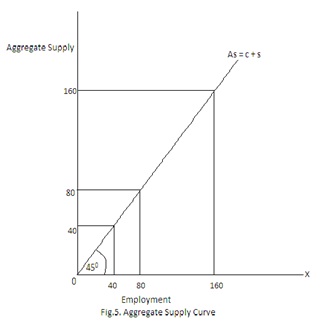Aggregate Supply
Aggregate Supply
Supply is a flow concept. It is different from the stock of goods. Aggregate supply is the flow of goods and services in the economy during a given period of time. In the short-run, it is related to the volume of employment of labour. In the schedule sense, we can define aggregate supply as “a schedule of the minimum amounts of proceeds required to induce entrepreneurs to give varying amounts of employment.” Further, supply or income is divided between consumption (c) and savings (s).
Y = C + S
In the short-run, aggregate supply changes with the change of labour employment, capital stock, technology remaining constant. That means as employment of labour increases in the short-run, total production and hence the supply of goods in the economy as a whole goes on increasing, other things remaining constant. Thus aggregate supply is an increasing function of aggregate income. For the sake of simplicity, let us assume that the aggregate supply bears a proportional relationship with the volume of employment. As aggregate employment increases, aggregate supply also increases proportionately. Let us took at the following table.
Table-2
Aggregate Supply Schedule
|
Employment |
Aggregate Supply |
|
0 40 80 100 |
20 50 80 160 |
Table 2 shows the proportional relationship between aggregate supply and aggregate employment. As employment increases, aggregate supply also increases proportionately. It may be represented in a straight line starting from the origin with 450 to the x-axis depicted in the following diagram.
The AS curve is the aggregate supply curve. This curve is upward sloping which shows that as aggregate employment goes on increasing in X-axis, aggregate supply also increases proportionately in Y-axis. This straight line indicates the cost of producing various levels of output as employment in the X-axis increases, The cost of production is the remuneration payable to factors of production including normal profit to the entrepreneur. The straight line, AS, therefore, indicates total income generated at various levels of employment. Keynes in “The Generd Theory” did not analyse aggregate supply function in detail because there was nothing new to add. In the short-run, supply conditions are given. Therefore, is the aggregate demand which plays the crucial role in the determination of the equilibrium level of income.

